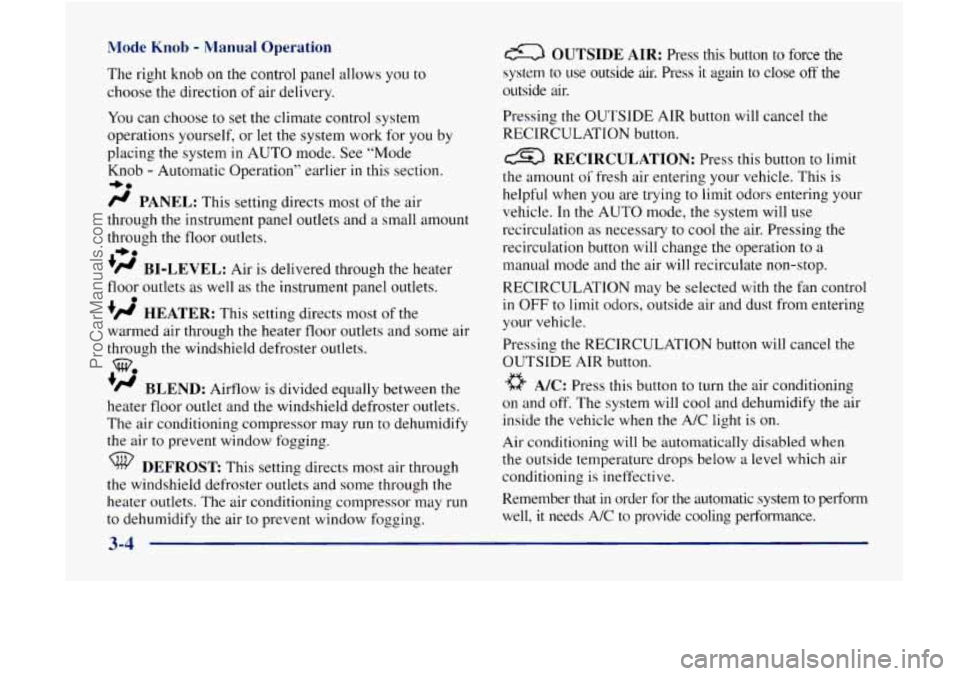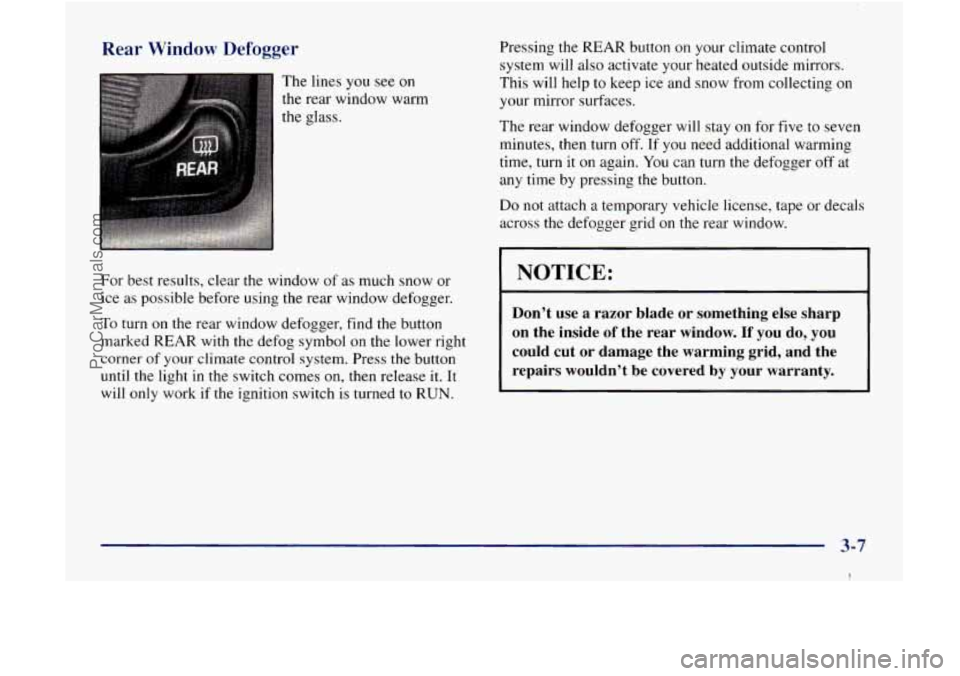1998 GMC ENVOY climate control
[x] Cancel search: climate controlPage 110 of 386

NOTICE:
Loading cargo that weighs more than 200 Ibs.
(91 kg) on the luggage carrier may damage your
vehicle. When you carry large things, never let
them hang over the rear or the sides of your
vehicle. When loading cargo on the roof panel, be
sure it rests on the slats and does not scratch or
damage the vehicle.
Put the cargo against the side rails and fasten it
securely to the luggage carrier. Put the main
weight as
far forward as you can and move the
rear crossrail forward as
far as possible to keep
the load from shifting.
Don’t exceed the maximum vehicle capacity when
loading your vehicle. For more information on vehicle
capacity and loading, see “Loading Your Vehicle“
in
the Index.
To prevent damage or loss of cargo as you’re driving,
check now and then to make sure the luggage carrier and
cargo are still securely fastened.
Ashtrays and Cigarette Lighter
The ashtray is located in the center floor console, in
front
of the shift lever. Flip the cover to expose
the ashtray.
NOTICE:
Don’t put papers and other things that burn into
your ashtray.
If you do, cigarettes or other
smoking materials could set them on fire
causing damage.
To remove the front ashtray, pull the bin upward.
The lighter is located
in the instrument panel below the
climate controls.
To use the lighter, press it in all the
way, and let
go. When it’s ready, it will pop back
by itself.
2-49
I
ProCarManuals.com
Page 134 of 386

Section 3 Comfort Controls and Audio Systems
In this section, you’ll find out how to operate the comfort control and audio systems offered with your vehicle. Be
sure to read about the particular systems supplied with your vehicle.
3-2
3-2
3
-5
3-5
3-5
3-6
3-7
3-8
3-8
3-8
Comfort Controls Electronic Climate Control System
Air Conditioning
Heating
Ventilation System
Defogging and Defrosting
Rear Window Defogger
Audio Systems Setting the Clock
AM-FM Stereo with Cassette
Tape Player 3- 12
3- 16
3-18
3-2 1
3-23
3-23
3-24
3-26
3-26
3-26
AM-FM Stereo with Compact Disc Player
(If Equipped)
Rear Seat Audio (RSA)
Console-Mounted CD Changer
Theft-Deterrent Feature
Understanding Radio Reception
Tips About Your Audio System
Care of Your Cassette Tape Player
Care
of Your Compact Discs
Care of Your Compact Disc Player
Fixed Mast Antenna
3-1
ProCarManuals.com
Page 135 of 386

I
Comfort Controls
With this system, you can control the heating, cooling
and ventilation in your vehicle.
AUTO: If the knob is in AUTO, the fan speed will vary
as the system maintains
the selected temperature.
Temperature Knob
Electronic Climate Control System
Fan Control
The knob on the left side of the climate control panel
controls the fan speed.
To manually increase airflow,
move the knob to the right. To manually decrease
airflow, move it to the left.
OFF: If the knob is in OFF, outside air will still enter
the vehicle, and will be directed based on the position of
the mode knob. The middle knob
on the control panel lets
you select the
desired air temperature in your vehicle. This knob will
allow you
to adjust the interior air temperature
independently of the function knob setting. Turn the
knob to the right toward 82 for warmer air. Turn the
knob to the left toward
66 for cooler air.
Full Hot: If you turn the temperature knob past 82°F
(2SoC), the system will
go into the “full hot” mode. The
system will remain at that maximum heating setting and
the
fan will blow at the speed the fan knob is set to. If
the fan is in AUTO, it will run at full speed.
Full Cold: If you turn the temperature knob past 66°F
(19” C), the system will go into the “full cold” mode.
The system will remain at that maximum cooling setting
and the fan will blow at the speed the fan knob is set to.
If the fan is in AUTO, it will run at full speed.
Choosing either maximum setting will not cause the
system to heat or cool any faster.
3-2
ProCarManuals.com
Page 137 of 386

Mode Knob - Manual Operation
The right knob on the control panel allows you to
choose the direction
of air delivery.
You can choose to set the climate control system
operations yourself, or let the system work for you by
placing the system
in AUTO mode. See “Mode
Knob
- Automatic Operation” earlier in this section.
/J PANEL: This setting directs most of the air
through the instrument panel outlets and a small amount
through the floor outlets.
’@ BI-LEVEL: Air is delivered through the heater
floor outlets as well as the instrument panel outlets.
+# HEATER: This setting directs most of the
warmed air through the heater floor outlets and some air
through the windshield defroster outlets.
‘/J BLEND: Airflow is divided equally between the
heater floor outlet and the windshield defroster outlets.
The air conditioning compressor may run
to dehumidify
the air to prevent window fogging.
+0
-bo
0
WO
DEFROST This setting directs most air through
the windshield defroster outlets and some through the
heater outlets. The air conditioning compressor may
run
to dehumidify the air to prevent window fogging.
a OUTSIDE AIR: Press this button to force the
system to
use outside air. Press it again to close off the
outside air.
Pressing the
OUTSIDE AIR button will cancel the
RECIRCULATION button.
RECIRCULATION: Press this button to limit
the amount
oi’ fresh air entering your vehicle. This is
helpful when
you are trying to limit odors entering your
vehicle. In the AUTO mode, the system will use
recirculation as necessary to cool
the air. Pressing the
recirculation button will change the operation to
a
manual mode and the air will recirculate non-stop.
RECIRCULATION may be selected
with the fan control
in OFF to limit odors, outside air and dust from entering
your vehicle.
Pressing the RECIRCULATlON button will cancel the
OUTSIDE AIR button.
a A/C: Press this button to turn the air conditioning
on and off. The system will cool and dehumidify the air
inside the vehicle
when the A/C light is on.
Air conditioning will be automatically disabled when
the outside temperature drops below a level which air
conditioning is ineffective.
Remember that
in order for the automatic system to perform
well,
it needs A/C to provide cooling performance.
3-4
ProCarManuals.com
Page 140 of 386

Rear Window Defogger
The lines you see on
the rear window warm
the glass.
For best results, clear the window of as much snow or
ice
as possible before using the rear window defogger.
To turn on the rear window defogger, find the button
marked REAR with the defog symbol
on the lower right
corner of your climate control system. Press
the button
until the light in the switch comes on, then release it. It
will only work
if the ignition switch is turned to RUN.
Pressing the REAR button on your climate control
system will also activate your heated outside mirrors.
This will help to keep ice and snow from collecting
on
your mirror surfaces.
The rear window defogger will stay on for five
to seven
minutes, then turn
off. If you need additional warming
time, turn it on again. You can turn the defogger off at
any time by pressing the button.
Do not attach a temporary vehicle license, tape or decals
across the defnqger grid on
the rear window.
NOTICE:
Don’t use a razor blade or something else sharp
on the inside of the rear window. If you do, you
could cut or damage the warming grid, and the
repairs wouldn’t be covered by your warranty.
3-7
I
ProCarManuals.com
Page 289 of 386

Treadwear Temperature -- A, B, C
The
treadwear grade is a comparative rating based on
the wear rate of the tire when tested under controlled
conditions
on a specified government test course. For
example,
a tire graded 150 would wear one and a half
(1 1/2) times as well on the government course as a tire
graded
100. The relative performance of tires depends
upon the actual conditions
of their use, however, and
may depart significantly from the norm due to variations
in driving habits, service practices and differences in
road characteristics and climate.
Traction -- A, B, C
The traction grades, from highest to lowest, are A, B,
and C, and they represent the tire’s ability to stop on
wet pavement
as measured under controlled conditions
on specified government test surfaces
of asphalt and
concrete.
A tire marked C may have poor
traction performance.
Warning: The traction grade assigned to this tire is based
on braking (straight ahead) traction tests and does not
include cornering (turning) traction. The
temperature grades are
A (the highest), B, and C,
representing the tire’s resistance to the generation of
heat and its ability to dissipate heat when tested under
controlled conditions on
a specified indoor laboratory
test wheel. Sustained high temperature can cause the
material of the tire to degenerate and reduce tire life,
and excessive temperature can lead to sudden
tire
failure. The grade C corresponds to a level of
performance which all passenger car tires must meet
under the Federal Motor Vehicle Safety Standard
No. 109. Grades B and A represent higher levels of
performance on the laboratory test wheel than the
minimum required by law.
Warning: The temperature grade for this tire is
established for a tire that is properly inflated and not
overloaded. Excessive speed, underinflation, or
excessive loading, either separately or in combination,
can cause heat buildup and possible tire failure.
6-42
ProCarManuals.com
Page 376 of 386

Climate Control System ........................... 3-2
Clock. Setting
................................... 3-8
Comfort Controls
................................ 3-2
Console Mounted CD Changer
.................... 3- 18
Content Theft-Deterrent
......................... 2- I 1
Control of a Vehicle .............................. 4-6
ConvenienceNet
............................... 2-46
Convex Outside Mirror
.......................... 2-42
Coolant
.................................. 5-14. 6.21
Coolant Heater. Engine .......................... 2- 16
Courtesy Transportation ........................... 8-8
Cruise Control
................................. 2-33
Customer Assistance Information
................... 8- 1
Customer Satisfaction Procedure .................... 8-2
Compact Disc Care
............................. 3-26
Dama. ue. Finish
............................... 6-52
Damage. Sheet Metal ............................ 6-5 1
Daytime Running Lamps ......................... 2-37
Dead Battery
................................... 5-3
Defects. Reporting Safety
........................ 8- IO
Defensive Driving ............................... 4-2
Defrosting
..................................... 3-6
Dimensions. Vehicle
............................ 6-62
Dome Lamps
.................................. 2-39
DoorLocks
..................................... 2-4
Drive
........................................ 2-19
Drive Axle Service
.............................. 7-44
Defogging
..................................... 3-6 Driver Information System
....................... 2-43
Driver Position
................................. i . 12
Driving
City
........................................ 4-31
Defensive
.................................... 4-2
Drunken ..................................... 4-3
Foreign Countries
.............................. 6-5
Freeway
.................................... 4-32
Guidelines
.................................. 4-14
Hill and Mountain Roads ....................... 4-34
In a Blizzard ................................. 4-38
Night
...................................... 4-27
Off-Road
................................... 4-15
OnCurves ...................................
4-9
Rainy Conditions ............................. 4-28
Snowy and Icy Conditions
...................... 4-36
Through Deep Standing Water
................... 4-30
WetRoads
.................................. 4-28
Winter
...................................... 4-36
With
a Trailer ................................ 4-48
Driving On Grades While Towing
a Trailer ........... 4-50
Drunken Driving
................................ 4-3
Electrical Equipment. Adding
............... 3.24. 6.54
Electrical System
............................... 6-54
Electrochomic Inside Day/Night Rearview Mirror
..... 2-40
Electronic Level Control
......................... 4-42
Engine
........................................ 6-9
Coolant Heater
............................... 2-16
Coolant Level Check
.......................... 7-39
Coolant Temperature Gage ..................... 2-66
9-3
ProCarManuals.com